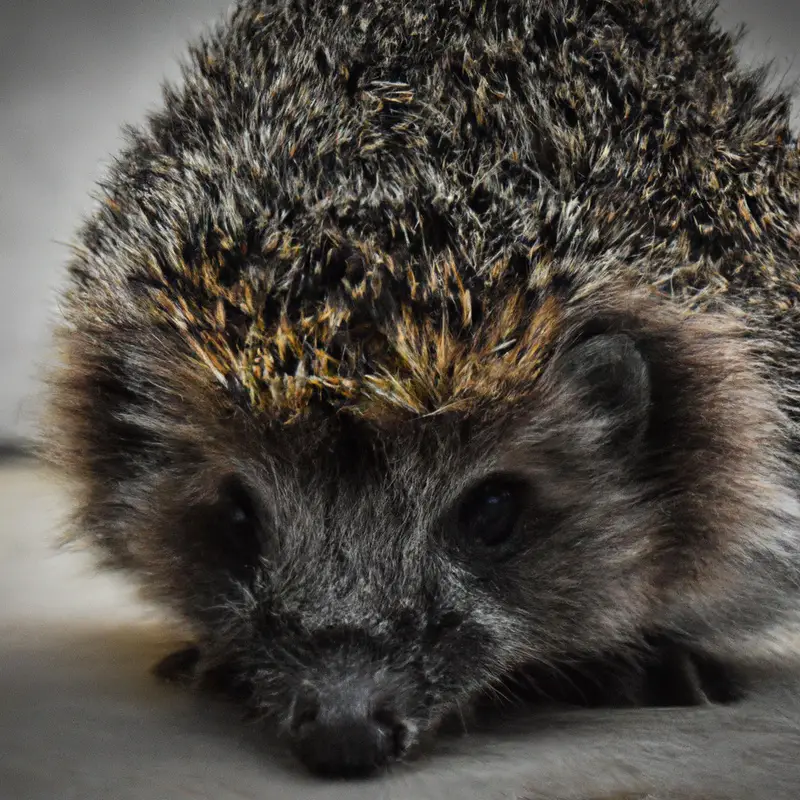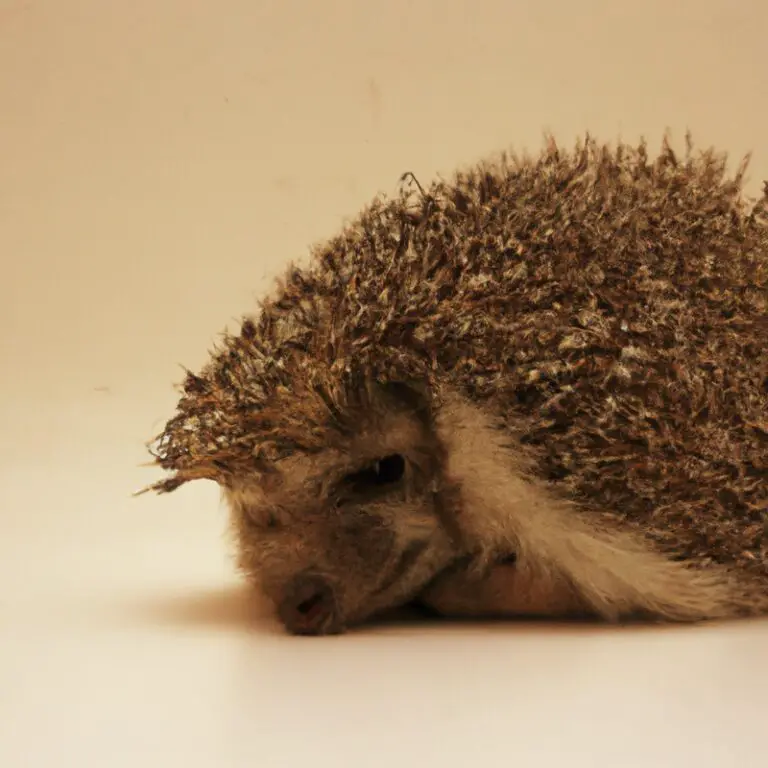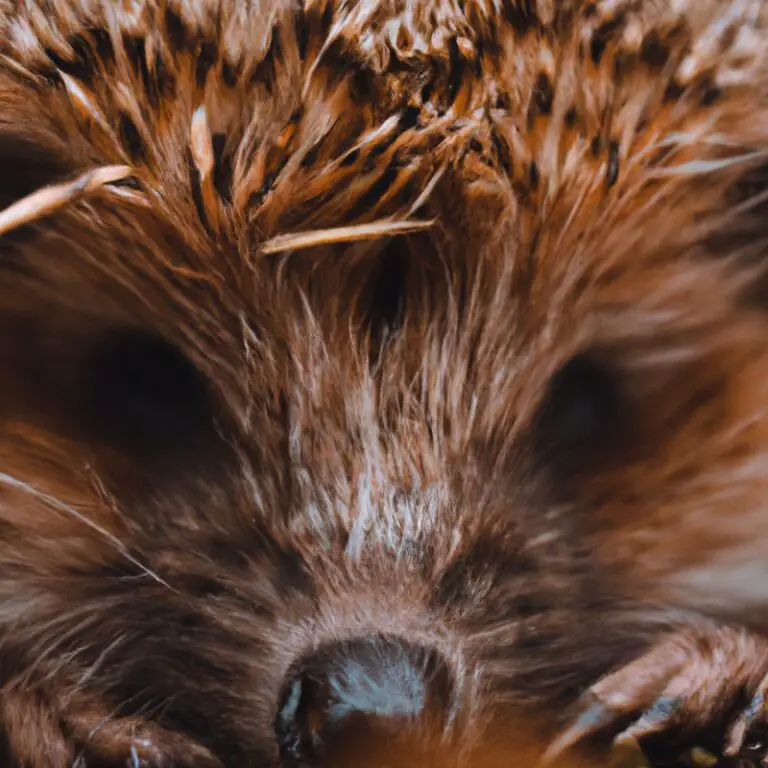How Do Hedgehogs Navigate Through Obstacles?
Key Takeaways:
- Hedgehogs have excellent hearing and a strong sense of smell, which help them navigate through obstacles.
- Hedgehogs use their quills and spines to sense their surroundings and detect obstacles.
- Hedgehogs can roll into a tight ball as a defensive mechanism when faced with obstacles.
- Hedgehogs have innate spatial awareness and can use it to navigate through complex environments.
Have you ever wondered how hedgehogs navigate through obstacles with such ease? These adorable creatures possess incredible instincts and adaptations that help them maneuver through their surroundings.
From their keen sense of smell and hearing to their unique quills, hedgehogs are well-equipped to handle any challenge that comes their way.
But what about their vision? How do they perceive their environment and detect obstacles?
And what strategies do they use to avoid getting in harm’s way?
In this article, we’ll dive into the fascinating world of hedgehog navigation and uncover the secrets behind their remarkable abilities. So, get ready to unravel the mysteries of how these spiky little creatures tackle the world around them.
The Natural Instincts of Hedgehogs
Hedgehogs possess innate instincts that help them navigate through obstacles.
Understanding Hedgehog Behavior
Understanding hedgehog behavior is important for taking care of these adorable creatures. Hedgehogs are nocturnal animals, which means they are most active at night.
They have excellent hearing and a keen sense of smell.
They are naturally shy and may curl up into a defensive ball when they feel threatened. Hedgehogs are solitary creatures and prefer to live alone.
They also have a natural instinct to explore and forage for food.
Providing them with a safe and stimulating environment is essential for their well-being.
Hedgehogs as Nocturnal Creatures
Hedgehogs are nocturnal creatures, meaning they are most active during the night. Their natural instincts have adapted to thrive in darkness.
Their excellent sense of hearing and smell helps them navigate and hunt for food in the dark.
They have sharp and flexible spines that protect them from predators while they search for insects and other small prey. Hedgehogs are truly fascinating nighttime dwellers.
Their Sense of Smell and Hearing
Hedgehogs have an incredible sense of smell and hearing, which play crucial roles in their navigation through obstacles. Their sense of smell allows them to detect food, predators, and even potential mates.
This sense is heightened by their long, sensitive noses and numerous olfactory receptors.
In addition, hedgehogs have excellent hearing, enabling them to detect approaching dangers and communicate with other hedgehogs. Their ability to pick up on subtle sounds helps them navigate their environment and avoid potential obstacles.
These sensory abilities are essential for hedgehogs to thrive in their natural habitats.

The Role of Quills in Navigation
Hedgehogs use their quills as an important sensory tool that aids in their navigation. The quills are highly sensitive to touch and vibrations, allowing hedgehogs to detect changes in their environment and avoid obstacles.
By relying on their quills, hedgehogs can feel their way through their surroundings and find their way around safely.
Quills serve as an integral part of hedgehogs’ natural instincts, helping them navigate through various terrains.

The Role of Vision in Hedgehog Navigation
Hedgehogs heavily rely on their vision to navigate through obstacles.
Hedgehog Visual Acuity
Hedgehogs have relatively poor visual acuity compared to humans.
They rely more on their other senses, such as hearing and smell, to navigate their surroundings.
While hedgehogs can see shapes and movement, their visual acuity is not sharp enough for precise detail or long-distance focus.
Instead, they use their excellent sense of smell and sharp hearing abilities to find their way and detect potential obstacles and sources of food.
Adaptations to Low-Light Environments
In low-light environments, hedgehogs have developed several adaptations to help them navigate effectively and find their way. They rely heavily on their sense of hearing, picking up on subtle sounds and vibrations to detect obstacles and potential threats.
Their whiskers, or vibrissae, are highly sensitive and help them sense changes in airflow as they move through their surroundings.
Additionally, hedgehogs have excellent night vision, as their eyes contain a higher concentration of rod cells, which are more sensitive to dim light. These adaptations, along with their keen sense of smell, allow hedgehogs to navigate successfully in low-light conditions.
Depth Perception and Obstacle Detection
Depth perception and obstacle detection are important abilities for hedgehogs to navigate through their environment. Hedgehogs have a keen sense of depth perception, allowing them to judge distances accurately.
This helps them avoid running into obstacles or falling into hazards.
Their sharp vision enables them to detect obstacles in their path, such as rocks or branches, and adjust their movements accordingly. This combination of depth perception and obstacle detection is crucial for hedgehogs to navigate safely and effectively in their surroundings.
The Influence of Color and Shape
Color and shape play a significant role in hedgehog navigation.
Hedgehogs have poor eyesight but can distinguish between different colors, helping them identify food sources and potential threats.
Bright colors might act as warning signals.
When it comes to shape, hedgehogs rely on their ability to squeeze through small gaps and navigate tight spaces.
The size and shape of objects in their environment help them determine the best path to take.
Overall, color and shape are crucial factors that influence hedgehog navigation through obstacles.
Hedgehog Movement and Obstacle Negotiation
Hedgehogs move with flexibility and agility to navigate obstacles in their path. They employ various strategies to avoid obstacles and can curl into a defensive ball if needed.
Hedgehog Locomotion
Hedgehogs have a unique way of moving around.
They use their strong muscles and long legs to walk and run.
When navigating through vegetation or rough terrain, hedgehogs have the ability to climb and swim if necessary.
They are also capable of rolling into a tight ball for protection, especially when faced with danger.
This form of locomotion allows them to adapt to their surroundings and survive in different environments.
Hedgehogs are fascinating creatures with versatile movement skills!
Flexibility and Agility
Flexibility and agility are key traits that allow hedgehogs to navigate through obstacles with ease.
Their flexible spines enable them to contort their bodies, allowing them to squeeze through tight spaces and maneuver around objects.
Additionally, their agile movements and quick reflexes help them quickly adjust their course and avoid potential dangers.
These abilities make hedgehogs adept at navigating their environment and finding their way around obstacles in their path.
Strategies for Avoiding Obstacles
Hedgehogs have several strategies for avoiding obstacles.
One technique is curling up into a ball and waiting for the obstacle to pass.
They can also use their sharp quills to create a barrier or detour around the obstacle.
Hedgehogs are also adept climbers and can navigate over obstacles.
Another strategy is using their excellent sense of smell to detect an obstacle in advance and adjust their path accordingly.
Sometimes, hedgehogs will simply change direction and find an alternative route.
These strategies help hedgehogs successfully navigate through their environment.
Rolling into a Defensive Ball
Rolling into a defensive ball is a well-known defense mechanism of hedgehogs.
When threatened or feeling unsafe, hedgehogs curl their bodies into a tight ball, with their spines on the outside for protection.
This behavior makes it difficult for predators to attack vulnerable areas.
Hedgehogs can roll into a ball quickly and easily due to their flexible spines and precise muscle control.
This defensive posture helps them survive in the wild.
Climbing and Swimming Abilities
Hedgehogs have impressive climbing abilities.
They are agile climbers and can scale trees, fences, and other obstacles using their sharp claws.
Their flexible spines also assist them in gripping onto surfaces.
However, hedgehogs are not good swimmers.
Their petite size and heavy weight make swimming challenging for them.
It is best to keep hedgehogs away from bodies of water to prevent any accidents.
Hedgehog Compass Sense and Navigation
Hedgehogs have a remarkable compass sense and navigation ability.
Magnetic Field Sensitivity
Hedgehogs have the ability to sense and navigate using magnetic fields.
This incredible sense allows them to find their way and avoid obstacles, even in the dark.
Magnetic field sensitivity is a key component of their navigation system, helping them to orient themselves in their surroundings.
This unique ability showcases the incredible adaptability and survival skills of these prickly little creatures.
Studying Orientation and Homing Behavior
Studying the orientation and homing behavior of hedgehogs is fascinating.
Researchers use various methods to understand how these small mammals navigate through their surroundings.
They observe their movements in controlled environments, track their journeys using GPS technology, and analyze their responses to different stimuli.
By studying their orientation and homing behavior, we gain valuable insights into their cognitive abilities and innate navigation skills.
These findings help us better understand how hedgehogs adapt and survive in their natural habitats.
Hedgehog Migrations
Hedgehogs migrate primarily to find food and suitable habitats.
They usually cover short distances during their migrations, typically within their home range.
Hedgehogs have a strong sense of smell, which helps them locate food sources along their migration path.
They navigate through obstacles by using their sharp spines and agile bodies to move through tight spaces.
During migration, hedgehogs may encounter various obstacles such as fences and roads, but they adapt by using their natural instincts to find alternative routes.
Role of Sunlight and Celestial Cues
Hedgehogs rely on sunlight and celestial cues to navigate through obstacles. They have a remarkable ability to sense the position of the sun, even when it’s hidden behind clouds or at night.
This helps them orient themselves and move in the right direction.
Additionally, hedgehogs can also detect subtle changes in celestial patterns, such as the position of the stars and the moon, to navigate their surroundings. These natural cues serve as a compass for hedgehogs, allowing them to navigate with precision and avoid obstacles in their path.
Encountering Obstacles in Urban Environments
Hedgehogs in urban environments often come across obstacles like roads, fences, and walls.
Hedgehogs and Roads
Hedgehogs and roads can be a dangerous combination.
These small creatures often encounter obstacles like roads when they are out and about.
Unfortunately, hedgehogs are not well-equipped to navigate busy streets.
Their small size and slow movements make them vulnerable to traffic.
To help protect hedgehogs, it’s important to be aware of their presence on the roads, especially during nighttime when they are most active.
To prevent accidents, consider slowing down and being cautious when driving through areas known to have hedgehog populations.
It’s a simple action that can go a long way in ensuring the safety of these adorable creatures.
Fences and Walls: Overcoming Barriers
Fences and walls can pose challenges for hedgehogs, but they have ways of overcoming these barriers. Hedgehogs are able to navigate through small gaps or holes in fences or walls.
They may also use their strong sense of smell and hearing to find alternative routes around barriers.
Providing hedgehog-friendly access points or removing barriers can help ensure their safe movement through urban environments. Avoiding the use of solid fences or walls altogether can also create a more inviting habitat for hedgehogs.
Obstacles in Gardens and Backyards
Obstacles in gardens and backyards can pose challenges for hedgehogs. Fences and walls can prevent their movement, while closed gates and doors can block their access.
Ponds and swimming pools may cause accidental drowning.
Sharp garden tools and equipment can injure them. Chemicals and pesticides used on plants can be toxic.
Dense vegetation can make it difficult for hedgehogs to navigate.
By creating hedgehog-friendly features like small gaps in fences, providing open access to food and water, and avoiding the use of harmful chemicals, we can help hedgehogs overcome these obstacles and thrive in our gardens and backyards.
Hedgehog-Friendly Solutions
Hedgehog-Friendly Solutions for urban environments include creating hedgehog highways by removing or adapting fences, providing safe access points by creating small holes, and avoiding the use of pesticides and chemicals.
Additionally, maintaining a hedgehog-friendly garden by keeping it wild, providing shelter, and offering food and water can help these adorable creatures thrive.
Remember, small changes in our urban spaces can make a big difference in the survival and well-being of hedgehogs.
Frequently Asked Questions about Hedgehog Navigation
Can hedgehogs navigate in complete darkness?
Hedgehogs have limited vision, but they can navigate in complete darkness using their other senses. They have an excellent sense of smell and hearing, which helps them detect obstacles, find food, and navigate their surroundings.
Their whiskers, or “vibrissae,” are highly sensitive and can detect changes in air currents, allowing them to identify objects and obstacles.
Hedgehogs also have a good sense of touch, which helps them feel their way through their environment. These adaptations help hedgehogs navigate successfully, even in the absence of light.
Do hedgehogs use echolocation?
Hedgehogs do not use echolocation. Unlike bats and dolphins, hedgehogs rely primarily on their sense of hearing and smell to navigate through their environment.
Their excellent hearing allows them to detect potential dangers, locate food sources, and communicate with other hedgehogs.
Hedgehogs also use their sense of smell to mark their territory and find their way around. So while echolocation is a remarkable ability found in some animals, hedgehogs have their own unique methods of navigation.
Can hedgehogs climb trees?
Hedgehogs are not known for their tree-climbing abilities.
They are primarily ground-dwelling creatures and are not equipped with the physical adaptations necessary for climbing trees.
Their short legs and stout bodies are more suitable for navigating through grass and undergrowth rather than scaling vertical surfaces.
Hedgehogs are skilled at burrowing and can dig their way into tight spaces, but when it comes to climbing trees, they are not the most adept.
How do hedgehogs respond to human-made obstacles?
Hedgehogs have a remarkable ability to respond to human-made obstacles. They rely on their excellent sense of smell and hearing to detect changes in their environment.
When faced with obstacles such as fences or walls, hedgehogs use their sharp claws and strong legs to climb or dig under them.
They are also adept at squeezing through small gaps or openings. However, it’s important for us to minimize these obstacles to ensure their safety and freedom of movement.
Can hedgehogs swim?
Yes, hedgehogs can swim, but it’s important to note that not all hedgehogs are comfortable in the water. While some hedgehogs are natural swimmers and may even enjoy a dip, others may find it stressful or struggle in the water.
It’s best to avoid exposing hedgehogs to deep water or forcing them to swim unless necessary.
Always prioritize their safety and well-being.
Final Verdict
Hedgehogs possess remarkable natural instincts and adaptations that enable them to navigate through obstacles with ease.
Their keen sense of smell and hearing, combined with their excellent vision, allow them to detect and avoid obstacles in their path.
Hedgehogs’ ability to roll into a defensive ball and their climbing and swimming skills further aid them in negotiating obstacles.
Additionally, studies suggest that hedgehogs may rely on magnetic field sensitivity and celestial cues for navigation.
While urban environments present challenges, implementing hedgehog-friendly solutions can help mitigate obstacles.
Overall, hedgehogs are fascinating creatures with impressive navigational abilities that allow them to navigate their surroundings successfully.








